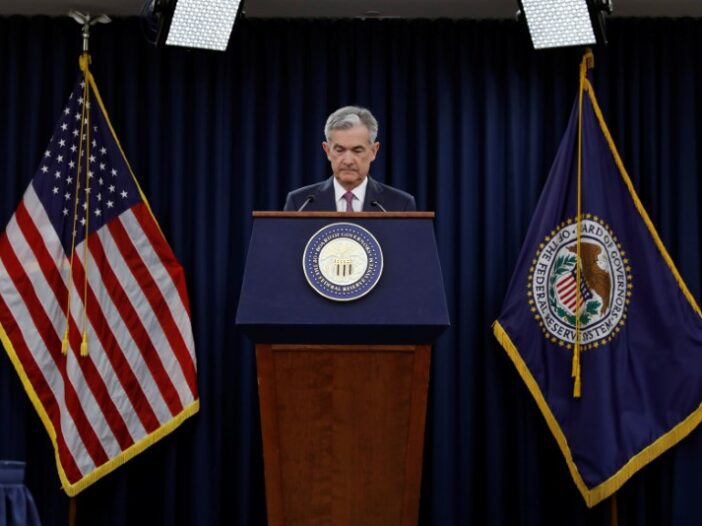The Fed actually did it…
They raised interest rates by 75 basis points.
A statement designed to (once and for all) try and get inflation under wraps.
As for whether or not it’ll work, we’ll have to wait and see. The fact that Powell hinted at more hikes to come, though, suggests the Fed is still worried.
My concern is that it still seems like the central bankers are fighting the wrong foe. For example, some of Powell’s comments following this rate rise show where the Fed’s head is at:
‘We are not trying to induce a recession. We’d like to see demand moderating because demand is very hot still in the economy.’
The problem with this train of thought is that a lot of the factors impacting inflation aren’t demand-related. We’re dealing with a lot more supply-side pressure on the price front, particularly when it comes to crucial goods like energy.
Raising interest rates, thereby putting more pressure on household budgets, isn’t going to alleviate that. In fact, it’s only going to make things worse for a lot of Americans.
For Aussies investors like yourself, the bigger question is what this rate rise may lead to in terms of global investment. After all, the last time the Fed issued a 75bps hike, it eventually led to the Tequilla crisis…
The moment that almost ended Mexico
See, back in 1994, the Fed was on a mission to stop a recession at all costs.
They were so worried about the ominous yield curve inversion that they raised rates by 250bps over a nine-month period. A streak that was capped off by a stunning 75bps hike in November of ‘94 — the last time, until today, the Fed has made such a drastic move.
And I say drastic because the consequences of this monetary policy stance at the time had some very big implications.
At face value, these hikes seemed like a roaring success. The US avoided the dreaded yield curve inversion and was rewarded with a ‘soft landing’ for the economy. No recession, no consumer pain.
For other economies, however, it was a very different story…
Mexico, for example, was easily the biggest loser. The neighbouring nation had recently become a key part of the NAFTA bloc, opening up new opportunities for not only exchange of goods but also international investment.
In fact, prior to the Fed’s 1994 rate hike spree, Mexico had become an investment hotspot. The liberalisation of its markets and banks had opened up plenty of opportunities for investors with a strong risk appetite.
Compared to the low rate and low yield mix in the US, this made Mexico very attractive.
That is until the Fed’s monster rate rises came into play.
Once that began, along with some political fumbles from Mexico itself, the investment dollars began to dry up. Instead, the higher yields in the US attracted far more attention. This naturally led to higher demand for the US dollar, which, in turn, put pressure on the Mexican peso.
Given that the peso was pegged to the US dollar at the time, you can understand how things got ugly fairly quickly. After all, in order to maintain the peg, the Mexican central bank had to constantly buy and sell pesos to stabilise its value.
Though, as US interest rates rose, the value of the US dollar soared. So on 20 December 1994, the newly elected Mexican government realised this peg wasn’t sustainable. In order to alleviate some pressure, they lifted the upper band of the exchange rate by 15% — a decision that signalled an immediate devaluation of the peso.
In the two days that followed, US$4.6 billion of capital fled Mexico.
Investors saw the writing on the wall, and they wanted out. In other words, the situation went from bad to worse.
The Fed’s slippery slope
At the time, no one really appreciated just how dire Mexico’s situation had become. It was one of the first times an economic crisis had been brought about by capital flight.
Had they been left to their own devices, it almost certainly would have led to a sovereign default too. The same kind of outcome that almost wiped out a handful of European nations back in ‘08 and ‘09.
The only reason Mexico (and Europe for that matter) avoided total disaster is because of bailouts:
‘President Clinton authorized the $20 billion loan from the ESF on Jan. 31, 1995. An additional $17.8 billion from the IMF and $10 billion from the Bank for International Settlements brought the total aid package up to nearly $50 billion.’
Without this intervention, Mexico’s economy almost certainly would have collapsed — an outcome that would have led to much more pain for global investors.
Therefore, this ‘Tequilla crisis’, as it was dubbed, was the first real case of something that was deemed ‘too big to fail’. A quip that no doubt still haunts the Fed and many investors to this day.
After all, as the Richmond Federal Reserve has since pondered (emphasis added):
‘Still, the event raised a number of lasting questions. Intervening to prevent the default of companies or countries creates a moral hazard problem; international investors might take larger and larger risks in the future if they believe they are protected from the consequences of failure.
‘The 1995 intervention was more than 10 times the size of the loans made to Mexico in 1982. And just two years later, the international community would fund a $118 billion loan to Thailand, Indonesia, and South Korea to prevent another crisis.’
Ever since this moment — the last 75bps rate hike — the Fed has been heading down this slippery slope. They have helped usher in a world where investors no longer fully grasp what risk is. The Fed has simply become a tool to inflate asset prices and placate markets.
That is the only rational conclusion you can draw from the insane monetary policy we’ve seen over the course of the pandemic. And it’s that same insane policy that you should expect to see when the Fed realises it’s careening the US into a recession with these rate rises.
As much as everyone is worried about inflation right now, don’t be shocked when the narrative suddenly changes. A turning point that will once again signal a risk-on frenzy for investors.
After all, the Fed can’t afford to not keep up the charade at this point.
The damage was already done way back in 1994.
The only question now is when will the next ‘too-big-to-fail’ moment arrive? Because when it does, you can practically count on the Fed to go back to its old ways.
I’m talking more stimulus, more QE, and more asset price inflation.
Because at the end of the day, that’s the only thing they really care about. And the only way everyday people like you and I can profit from it is by playing along.
As twisted as it is, now’s the time to start loading up for the next bull market.
Regards,
 |
Ryan Clarkson-Ledward,
Editor, Money Morning
Ryan is also co-editor of Exponential Stock Investor, a stock tipping newsletter that hunts down promising small-cap stocks. For information on how to subscribe and see what Ryan’s telling subscribers right now, click here.

